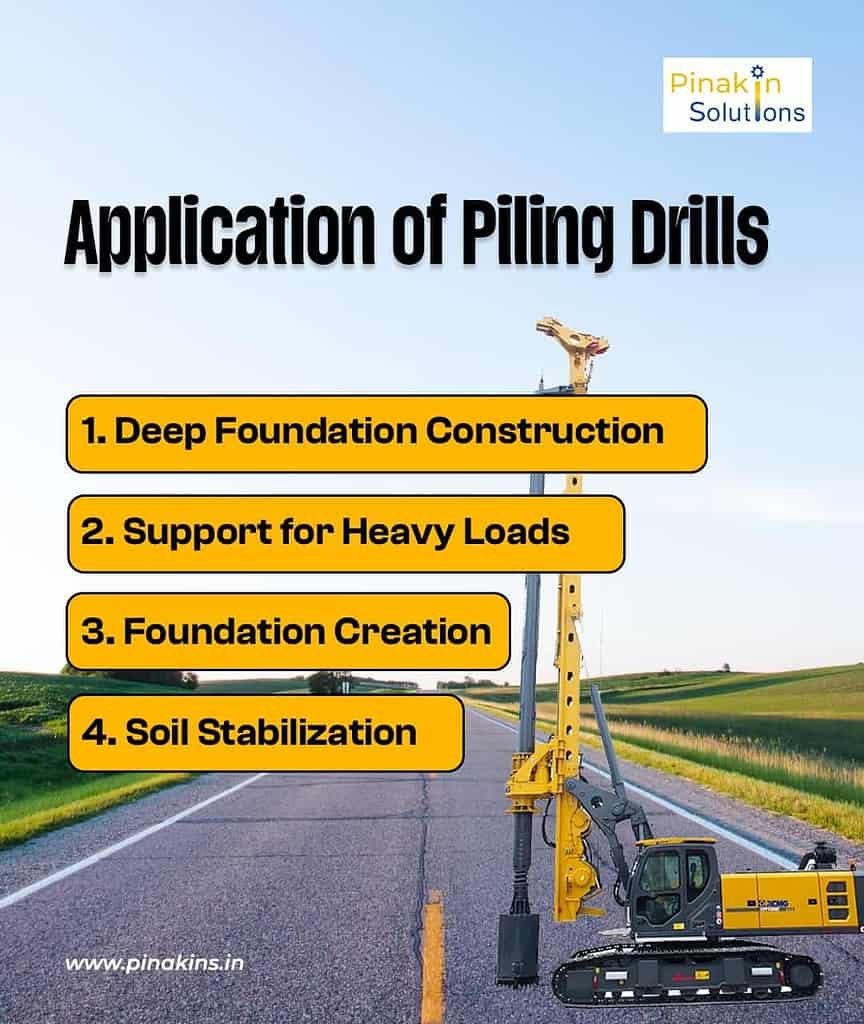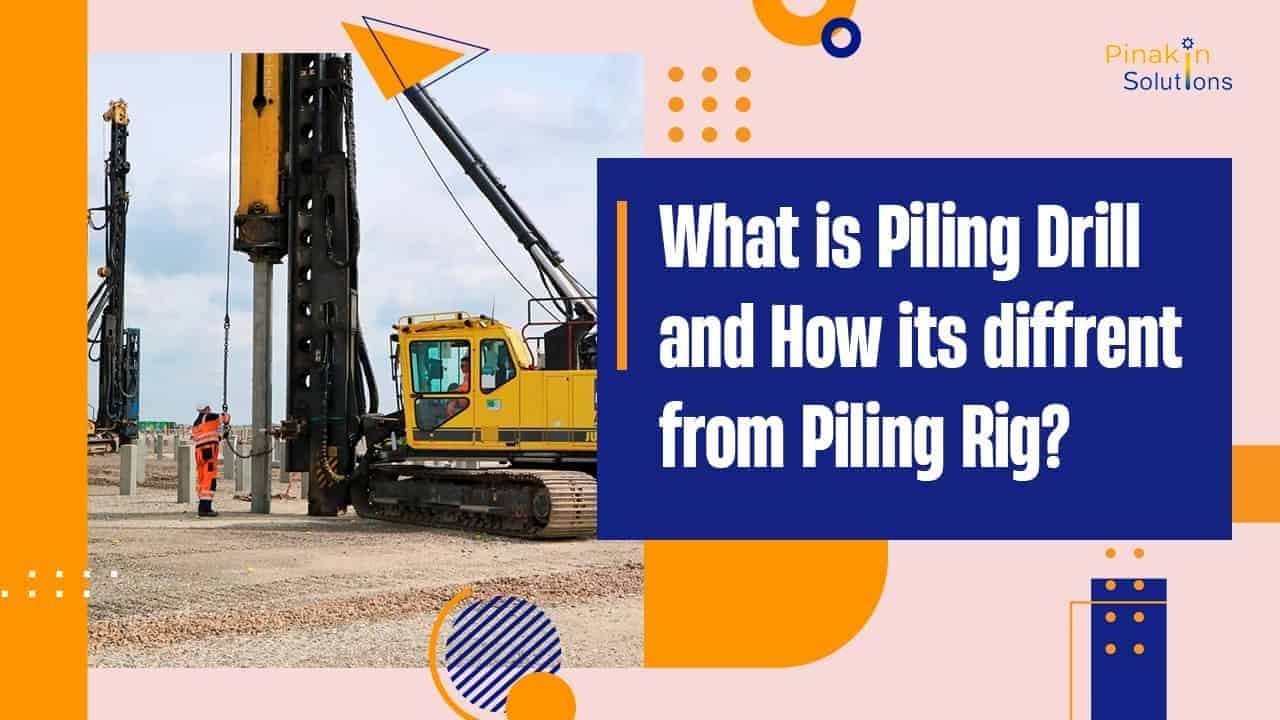Table of Contents
ToggleWhat is a Piling drill?
A piling drill, also known as a pile drill or piling rig, is a specialized construction machine designed for drilling holes or piles into the ground to create a foundation for various structures. Piling drills are equipped with powerful drilling mechanisms that can penetrate different types of soil and rock, depending on the specific requirements of a construction project.
These machines are commonly used in foundation construction for buildings, bridges, roads, and other infrastructure projects. Piling drills can create holes of various diameters and depths, and they are crucial for ensuring the stability and load-bearing capacity of the foundation.
Does the Piling drill and Piling rig are the same?
I understand the confusion, but the terms “piling drill” and “piling rig” are often used interchangeably and can refer to the same equipment, depending on regional terminology and industry context.
Both terms typically describe machinery used in the construction industry for drilling, boring, or driving piles into the ground as part of foundation construction. These machines can be quite versatile and can perform various functions related to foundation work.
In some regions or industries, one term may be more commonly used than the other, but they generally refer to the same type of equipment. It’s essential to consider the specific context in which these terms are used and the features and capabilities of the equipment in question when discussing piling machinery.
Piling Drill vs. Piling Rig
“Piling drill” and “piling rig” are terminologies often used interchangeably in the construction industry, but they can refer to slightly different equipment depending on the context. Here’s a comparison between the two:
Piling Drill:
A “Piling drill” typically refers to the drilling component of the equipment used in the piling process.
- It is the part of the machinery responsible for creating holes or piles in the ground to accommodate foundational elements like piles or caissons.
- Piling drills can come in various forms, such as rotary drills, auger drills, or even specialized drills for specific soil and rock conditions.
- Piling drills are focused on the drilling aspect and may not include the entire rig’s components.
Piling Rig:
A “piling rig,” on the other hand, refers to the complete machinery used for pile foundation construction.
- It encompasses not only the piling drill but also various other components necessary for the entire piling process, including the crane, hydraulic systems, control panel, and more.
- Piling rigs are comprehensive machines designed for drilling, driving, or boring holes into the ground and installing piles or caissons as part of the foundation.
- Piling rigs are versatile and can handle various piling techniques, making them suitable for a wide range of construction projects.
- In essence, while “piling drill” emphasizes the drilling aspect of the equipment, “piling rig” encompasses the entire machinery used for pile foundation construction, including drilling, driving, and installation processes. The choice between a piling drill and a complete piling rig depends on the specific requirements of the construction project and the techniques involved in creating the foundation.
Difference between a Piling Drill and a Piling Rig:
| Characteristic | Piling Drill | Piling Rig |
| Function | Primarily focused on drilling holes or piles in the ground. | A comprehensive machine designed for various foundation construction processes, including drilling, driving, and installation. |
| Components | Include the drilling mechanism and associated components, such as the drill bit or auger. | Comprises multiple components, including the drilling mechanism, crane, hydraulic systems, control panel, and other elements necessary for the entire piling process. |
| Versatility | May have limited functionality and may be specialized for specific drilling tasks. | Versatile and adaptable, capable of handling various piling techniques and construction projects. |
| Scope of Work | Typically used for drilling holes or creating piles in the ground but may require additional equipment for the complete piling process. | Capable of performing the entire piling process, from drilling to pile installation, without the need for additional machinery. |
| Common Usage | May be used in smaller-scale projects or for specialized drilling tasks. | Commonly used in large-scale construction projects, including high-rise buildings, bridges, and infrastructure developments. |
| Complexity | Generally simpler in terms of design and functionality. | More complex due to the inclusion of multiple systems and components. |
| Mobility | Can be more portable and manoeuvrable. | Often larger and less mobile due to the inclusion of additional components. |
| Cost | tends to be more cost-effective for specific drilling tasks. | Typically more expensive but offers greater functionality for comprehensive foundation construction. |
Please note that while these differences highlight the general distinctions between piling drills and piling rigs, the specific capabilities and features of these machines can vary widely depending on their make, model, and purpose.
Must Read These Also.
- Vibratory Hammer: Unveiling the Power Behind Precise Foundation Construction
- Vibratory Hammer on Rent: Enhancing Construction Efficiency and Flexibility
Application of Piling Drills
- Foundation Creation: Piling drills are primarily used to create holes or piles in the ground, which serve as the foundation for buildings, bridges, and various infrastructure projects.
- Soil Stabilization: They are instrumental in stabilizing loose or problematic soil to ensure the safety and longevity of structures.
- Deep Foundation Construction: Piling drills are essential for constructing deep foundations, especially in areas with challenging soil conditions.
- Support for Heavy Loads: These machines are capable of creating foundations that can bear the immense weight of skyscrapers and large structures.

Types of Piling Drills
- Rotary Piling Drills: These drills use a rotating drill bit or auger to excavate soil and create holes. They are versatile and suitable for a wide range of soil types.
- Auger Piling Drills: Auger drills use a helical screw-like tool to remove soil and create holes. They are known for their precision in maintaining hole dimensions.
- Hydraulic Piling Drills: Hydraulic drills use hydraulic power for drilling. They offer significant force and speed, making them ideal for large-scale projects.
- Crawler-Mounted Piling Drills: These drills are mounted on tracks, providing excellent mobility in challenging terrains.
Use Cases for Piling Drills
Case 1: Skyscraper Construction
Challenge: Building skyscrapers requires strong and deep foundations to support their massive weight.
Solution: Piling drills create deep, load-bearing foundations, ensuring the safety and stability of these tall structures.
Case 2: Bridge Foundations
Challenge: Bridges must withstand heavy traffic loads and environmental factors.
Solution: Piling drills are used to create solid abutments and piers, ensuring bridge stability and longevity.
Case 3: Soil Stabilization
Challenge: Unstable or loose soil can jeopardize construction projects.
Solution: Piling drills stabilize soil, providing a secure base for construction.
Piling Drill Case Study
- Project: The Sky Tower
- Challenge: Construct a 100-story skyscraper in an urban area with soft soil.
- Solution: Rotary piling drills were used to create deep foundation piles, ensuring the tower’s stability.
- Result: The Sky Tower stands as an iconic landmark, thanks to the precision of piling drills.
Read More:
- Boom Placers: Enhancing Efficiency and Precision in Construction Projects
- Boom Placer Pros and Cons of Purchasing vs. Renting the Machine
FAQs About Piling Drills
Q1: How deep can piling drills bore?
Answer: Piling drills can reach varying depths, from 10 meters to well over 100 meters, depending on the machine type and specifications.
Q2: Are piling drills environmentally friendly?
Answer: Modern piling drills are designed to minimize environmental impact, with reduced noise and vibration levels, and they adhere to stringent environmental regulations.
Q3: What is the typical lifespan of a piling drill?
Answer: The lifespan of a piling drill varies based on usage, maintenance, and build quality. With proper care, they can remain operational for 10 to 20 years or more.
Data Comparison: Using Piling Drills vs. Not Using Piling Drills
To highlight the advantages of using piling drills, let’s consider a hypothetical scenario comparing a construction project with and without piling drills:
Scenario 1: Without Piling Drills
- Foundation Construction: Conventional methods require extensive excavation, longer construction time, and higher labor costs.
- Soil Stabilization: Soil instability may lead to future structural issues, necessitating costly repairs.
- Project Duration: The project may experience delays due to complex foundation work.
Scenario 2: Using Piling Drills
- Foundation Construction: Piling drills expedite hole creation, reduce labor costs, and ensure precise foundation placement.
- Soil Stabilization: Stable foundations prevent future structural problems and associated expenses.
- Project Duration: Efficient foundation work contributes to on-time project completion.
In this comparison, using piling drills not only accelerates construction but also enhances the structural integrity of the project, ultimately saving time and money.
Piling drills are indispensable tools in the construction industry, revolutionizing foundation work and enabling the realization of complex and towering structures. Their precision, versatility, and environmental considerations make them essential assets in modern construction projects.
Conclusion:
In this comprehensive guide, we explored the various aspects of piling drills, including their use, types, applications etc. Piling drills are crucial tools in the construction industry, playing a pivotal role in creating stable and robust foundations for a wide range of structures.





